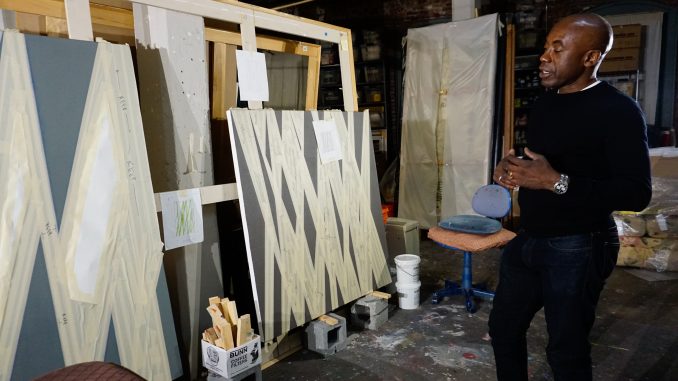
Odili Donald Odita sees more than color and geometric shapes when he looks at one of his murals. As a Black artist, he said painting them is a “political act.”
“[In] the early 20th century, Black artists didn’t have ownership of anything … except for maybe their own experience,” Odita said.
Odita, a painting professor, is one of several Temple professors who examines racial and cultural identity through art. Odita paints abstract art, a genre he said has historically diminished the accomplishments of Black artists.
“Black artists were seen to have more strength if they spoke about their particular plight as seen by the greater public, the greater intelligentsia,” Odita said. “If the work didn’t look like it spoke about Black issues or civil rights issues, then it wasn’t relevant.”
Although many curators valued only this narrow expression of the Black experience, Odita said some white artists achieved success by appropriating Black visual styles.
According to the Metropolitan Museum of Art’s Heilbrunn Timeline of Art History, a resource for critical essays and chronologies, European cubist painters like Pablo Picasso were influenced by the “highly stylized treatment of the human figure in African sculptures.”
“If you look at early Cubism, it’s almost like a straight one-on-one copy of African masks,” Odita said.

While Cubists drew inspiration from African art, Odita said they presented their work as solely a modern creation. By doing so, they erased “the locality, the local politics, the local identities, the local histories that are at the foundation [of African art],” he said.
In contrast to this approach, Odita creates his abstract murals to reflect the local culture of where they are exhibited. One of his works, the ‘Forever’ Mural, represents the endurance of New Orleans through periods of calamity, like the destruction caused by Hurricane Katrina in 2005. At the end of December, the ‘Forever’ Mural will conclude its five-year display in the lobby of the New Orleans Museum of Art.
The mural consists of three separate panels, each one an arrangement of colorful shapes. At the center of the piece, abstract rays of color converge to suggest a dancing figure in the white space. Odita said he placed this image in the mural to highlight the significance of masquerade and Mardi Gras celebrations to New Orleans’ culture.
Keith Morrison, a painting professor, also explores cultural identity in his artwork. He describes himself as a “hybrid person,” which he said is a result of growing up in Jamaica.
“Many of my white friends were born in the same place that their grandfathers were born,” he said. “For Black people, it’s incredibly unusual. … From slavery, families were split apart, languages were changed.”
Morrison’s figurative paintings often illustrate the cultural misunderstandings wrought by slavery and migration. For example, his 1991 painting, “Tombstones” depicts a Black gang in African masks alongside an arrangement of gold chains and sneakers.
“A lot of kids misunderstand what African culture is,” Morrison said. “They wear African garb as style without knowing exactly what it means. Then they put it together with fancy jewelry, which is almost like a contradiction.”

Although “Tombstones” received some criticism for its negative portrayal of young Black people, Morrison said the painting’s purpose was to show “the social [and] political confusion” he experienced while living in inner-city Washington, D.C.
Jessica Hamilton, a jewelry artist and Africology and African American Studies doctoral student, said she thinks Black cultural representation is also important in wearable art.
“I am very much interested in this idea of tacit revolutions, this idea that I can wear something and it feeds the imagination, it feeds cultural connection, it feeds expression,” Hamilton said. “So you can have, for example, a button of an ‘ankh,’ [the ancient Egyptian symbol for ‘life’], that could represent Egypt, but also represent you and your connection to the continent [of Africa].”
Hamilton designs large, crystal-based jewelry. She compares her work to “amulets,” ornaments that provides protection from harm.
“A lot of my work is … beyond just being a piece of jewelry, but something that empowers, inspires or helps people to amplify whatever it is that they need to in their lives.”
For Morrison, Black art needs to express complexities and contradictions because they define the African-American experience.
“I think any people, Black people, white people, Asian people, have within them confusions, and anxieties and uncertainty,” Morrison said. “All the people that I’ve known have contradictions, confusions and I think Black people are deserving to have those as much as anyone else.”
Ian Walker can be reached at ian.walker@temple.edu or on Twitter @ian_walker12.


Be the first to comment